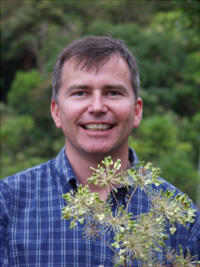Sept. 24, 2002
Popular plant is sold under wrong name
Long-suffering Schefflera needs a new label
Share this story

RICHMOND, Va. – Often neglected in office corners and frequently over watered with the other houseplants, Schefflera – or umbrella tree – is a foliage plant well known to gardeners worldwide. Some of the leafy, showy trees can grow to well over six feet tall.
Soon, gardeners and horticulturists may need to call Schefflera by another name.
A botanist at Virginia Commonwealth University and his fellow researchers say DNA testing of a broad sampling of the 650 species that make up the huge genus Schefflera suggests that more than 640 of those species have been misclassified and should be renamed. According to the DNA data, only seven species legitimately belong to the genus Schefflera. These seven species all grow in the wild on islands in the western Pacific Ocean, and none have been widely marketed as cultivated plants in the Northern Hemisphere.
Those Schefflera plants being sold in garden centers now? They’re something else.
“Over the past 30 years, the genus Schefflera has been greatly expanded to include many species of plants once treated as distinct but that share certain characteristics – including divided leaves with a palm-like arrangement of leaflets, unarticulated pedicels and unarmed vegetative parts,” said Gregory M. Plunkett, pictured right, associate professor of biology at VCU. “This broad definition of Schefflera has allowed the genus to swell so that it now represents more than half of the species diversity found in its plant family.
“However, our DNA-based studies suggest that these plants represent at least five different genera, originating in five distinct geographic regions.”
Schefflera belongs to the ginseng, or ivy family of plants known formally as Araliaceae. The family includes more than 1,200 species of shrubs and small trees, most of which are native to the tropics and subtropics, especially in southeastern Asia and the Pacific Islands. Schefflera, named in honor of the 19th Century German botanist J.C. Scheffler, is distinguished by its palm-like leaves that form an umbrella-shaped rosette.
Plunkett and other botanists have been collecting samples of plants from around the world, including Australia, New Zealand, New Caledonia and other Pacific islands, Madagascar and tropical Africa, Central and South America and southeastern Asia. Using molecular data, they have been studying the relationships and classification of the family Araliaceae over the past decade. Most current classifications in the family date back to the late 19th and early 20th centuries, before DNA testing of plants was possible.
“Before gene sequencing, relationships among these plants were more difficult to figure out,” Plunkett said. “The molecular data are able to provide us new insights. For example, we now know that there is no practical way to maintain the current classification system for this genus, and only a handful of plant species can maintain the name Schefflera.”
The seven species that still will be called Schefflera are native to the Pacific islands, ranging from New Zealand to Samoa and Vanuatu.
Three species dominate the cultivated houseplant market. They are known as dwarf schefflera (Schefflera arboricola), umbrella or octopus tree (Schefflera actinophylla) and false aralia (Schefflera elegantissima). These common houseplants will have to be renamed, as will most of the other plants growing in the wild that are now referred to as Schefflera.
Plunkett is preparing a scientific paper on the Schefflera findings along with two collaborators: Renowned Schefflera expert David G. Frodin of the Royal Botanic Gardens in Kew, England, and Porter P. Lowry II, of the Missouri Botanical Garden in St. Louis and the Museum National d’Histoire Naturelle in Paris. Plunkett said the paper will list accurate identities of about one tenth of the species now called Schefflera. Additional research to identify the rest could take several years.
Plant names are governed by the International Code of Botanical Nomenclature. The code will next be reviewed at the July 2005 meeting of the International Botanical Congress in Vienna.
Subscribe to VCU News
Subscribe to VCU News at newsletter.vcu.edu and receive a selection of stories, videos, photos, news clips and event listings in your inbox.









